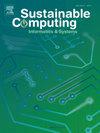Sustainable IoT solutions: Developing a quantum-aware circuit for improving energy efficiency based on atomic silicon
IF 5.7
3区 计算机科学
Q1 COMPUTER SCIENCE, HARDWARE & ARCHITECTURE
引用次数: 0
Abstract
Internet of Things (IoT) can be described as a network of physical objects equipped with sensors, processing power, software, and any other types of technology that allows them to communicate and share data with other devices and systems. The proliferation of IoT is conditional on developing energy-saving blocks of computation with sustained connectivity and real-time information processing capabilities. Traditional technologies like CMOS and VLSI circuits face critical failures at scales below 4 nm, including excessive current leakages, high energy consumption, and thermal instability, which make them less appropriate for future micro-scale IoT chips. To overcome such limitations, a new alternative technology called Atomic Silicon Dangling Bond (ASDB) nanotechnology has been developed, leveraging atomistic accuracy in countering CMOS-related inefficiencies and supporting quantum-inspired computational processes. Since Arithmetic and Logic Unit (ALU) is a primary unit of any digital system like IoT, this work introduces the necessity of quantum-aware ALU development, taking a quantum-inspired computational mechanism and leveraging ASDB’s native quantum behavior for increased performance, accuracy, and efficiency in IoT systems. A single-bit ALU for micro-IoT blocks is developed using ASDB nanotechnology with robust computational design to guarantee operational integrity. The design is analyzed through SiQAD simulator in terms of energy consumption, logical accuracy, and area consumption. The proposed ALU in this work demonstrates a reduction in occupied area and quantum cell count, highlighting a significant step toward ultra-dense integration. Furthermore, with an energy consumption reduction of 3.19% compared to the best design, this ALU offers a sustainable and practical solution for low-power IoT applications in the future.
可持续的物联网解决方案:开发量子感知电路,以提高基于原子硅的能源效率
物联网(IoT)可以被描述为配备传感器、处理能力、软件和任何其他类型技术的物理对象的网络,这些技术允许它们与其他设备和系统进行通信和共享数据。物联网的扩散取决于开发具有持续连接和实时信息处理能力的节能计算块。CMOS和VLSI电路等传统技术在4 nm以下的尺度上面临严重故障,包括过度的电流泄漏、高能耗和热不稳定性,这使得它们不太适合未来的微尺度物联网芯片。为了克服这些限制,一种名为原子硅悬空键(ASDB)纳米技术的新替代技术已经开发出来,利用原子精度来对抗cmos相关的低效率,并支持量子启发的计算过程。由于算术和逻辑单元(ALU)是任何数字系统(如物联网)的主要单元,因此本工作介绍了量子感知ALU开发的必要性,采用量子启发的计算机制并利用ASDB的原生量子行为来提高物联网系统的性能,准确性和效率。微物联网模块的单比特ALU采用ASDB纳米技术开发,具有强大的计算设计,以确保操作完整性。通过SiQAD仿真器对该设计进行了能耗、逻辑精度、面积消耗等方面的分析。在这项工作中提出的ALU显示了占用面积和量子细胞计数的减少,突出了向超密集集成迈出的重要一步。此外,与最佳设计相比,该ALU能耗降低了3.19%,为未来的低功耗物联网应用提供了可持续和实用的解决方案。
本文章由计算机程序翻译,如有差异,请以英文原文为准。
求助全文
约1分钟内获得全文
求助全文
来源期刊

Sustainable Computing-Informatics & Systems
COMPUTER SCIENCE, HARDWARE & ARCHITECTUREC-COMPUTER SCIENCE, INFORMATION SYSTEMS
CiteScore
10.70
自引率
4.40%
发文量
142
期刊介绍:
Sustainable computing is a rapidly expanding research area spanning the fields of computer science and engineering, electrical engineering as well as other engineering disciplines. The aim of Sustainable Computing: Informatics and Systems (SUSCOM) is to publish the myriad research findings related to energy-aware and thermal-aware management of computing resource. Equally important is a spectrum of related research issues such as applications of computing that can have ecological and societal impacts. SUSCOM publishes original and timely research papers and survey articles in current areas of power, energy, temperature, and environment related research areas of current importance to readers. SUSCOM has an editorial board comprising prominent researchers from around the world and selects competitively evaluated peer-reviewed papers.
 求助内容:
求助内容: 应助结果提醒方式:
应助结果提醒方式:


